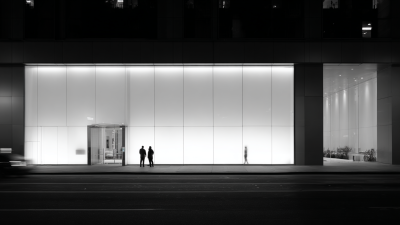



In the competitive landscape of modern business, the significance of a well-crafted Business Sign cannot be overstated. As Johnathan Green, a leading expert in branding and signage, aptly states, "A Business Sign is more than just a marker; it's the first impression that encapsulates your brand's identity." This insight underscores the pivotal role that signage plays in establishing a robust brand presence and attracting customers.

Choosing the right Business Sign involves understanding not only the aesthetic appeal but also the underlying message it conveys to the target audience. Factors such as design, color scheme, placement, and materials must all be considered to ensure the sign aligns with the brand's values and mission. In a world where attention spans are fleeting, an impactful Business Sign can be a game-changer, setting the tone for brand recognition and customer loyalty.
As we delve into the intricacies of selecting the best Business Sign for your brand's success, it is crucial to explore the range of options available and the strategies that can help businesses stand out in a crowded marketplace. By making informed decisions, brands can effectively communicate their essence and draw potential customers through the power of exceptional signage.
Effective business signage plays a crucial role in shaping brand identity and enhancing visibility in today's competitive landscape. According to a report by the Sign Research Foundation, about 76% of consumers believe that signage reflects the quality of a business. This statistic underscores the significance of well-designed signs not only as a branding tool but also as a means to convey professionalism and reliability to potential customers. A strong business sign essentially acts as a silent salesperson, drawing in customers and setting the tone for their overall experience with the brand.
Moreover, a study from the Federal Highway Administration notes that on average, outdoor signs account for about 50% of a business's customers. This insight emphasizes the essential role of effective signage in driving foot traffic and ultimately boosting sales. Choosing the right colors, fonts, and materials can reinforce brand values and create an immediate visual impact, making it easier for customers to remember and identify the business. In an era where brand recognition is key, investing in high-quality signage can significantly contribute to long-term brand success and a strong market presence.
 When selecting a business sign, several key factors should be carefully considered to ensure it effectively represents your brand. First, the sign’s visibility and readability are paramount. It should be easily recognizable from a distance, with clear fonts and contrasting colors that stand out against the background. Additionally, the sign's size should be appropriate for its setting, ensuring it is neither too overwhelming nor too subtle.
When selecting a business sign, several key factors should be carefully considered to ensure it effectively represents your brand. First, the sign’s visibility and readability are paramount. It should be easily recognizable from a distance, with clear fonts and contrasting colors that stand out against the background. Additionally, the sign's size should be appropriate for its setting, ensuring it is neither too overwhelming nor too subtle.
Another crucial factor is the sign’s material and durability. Depending on your location and climate, certain materials may withstand weather conditions better than others. Choosing high-quality materials not only enhances the sign’s longevity but also reflects the professionalism of your brand. Furthermore, consider your brand’s identity and messaging. The design elements, including logos, colors, and imagery, should align with your overall branding strategy to create a cohesive look that resonates with your target audience. By focusing on these aspects, you can select a business sign that not only attracts customers but also reinforces your brand's values and mission.
When selecting a business sign, it's essential to consider the specific needs of your industry. Retail businesses often benefit from vibrant and eye-catching signs that attract foot traffic. For example, a boutique may use stylish, illuminated storefront signage to showcase its unique brand while enticing passersby. In contrast, a restaurant might focus on clear, enticing menus and marquee signs that highlight daily specials, creating an inviting atmosphere that encourages customers to step inside.
Service-oriented businesses, such as salons or dental offices, should emphasize professionalism and trustworthiness in their signage. A clean, minimalistic approach can convey a sense of reliability, using professional fonts and soothing colors. Additionally, for industries like real estate, directional signs play a crucial role in guiding potential clients to listings. This type of signage should be straightforward and strategically placed to maximize visibility and impact. By understanding the distinct requirements of each industry, businesses can make informed choices that enhance their brand presence and drive success.
This chart illustrates the popularity of different types of business signs across various industries, highlighting the significance of visual branding for success.
The colors and fonts chosen for a business sign are crucial elements that directly influence brand recognition and consumer perception. Colors evoke emotions and convey messages even before potential customers read any text. For instance, blue is often associated with trust and professionalism, making it a popular choice for financial institutions. In contrast, vibrant colors like red and yellow can evoke energy and excitement, suitable for restaurants or entertainment businesses. Thus, selecting the right color palette not only enhances visibility but also strategically aligns with the brand's identity and values.

Fonts also play a significant role in making a business sign effective. The choice of typeface contributes to the overall tone of the brand; for example, a playful, rounded font might resonate well with a children’s store, while a sleek, sans-serif font could communicate modernity and sophistication for tech companies. It’s essential to ensure that the font is legible from a distance, as readability can significantly impact customer engagement. By harmonizing color and typography, businesses can create impactful signage that resonates with their target audience and reinforces their brand presence in a competitive market.
When budgeting for your business sign, it's essential to consider various factors that contribute to the overall cost. A report by the SIGN Research Foundation indicates that effective signage can increase brand awareness by up to 75%, making it a worthwhile investment. However, the initial expense can range from a few hundred to several thousand dollars, depending on the size, material, and design of the sign. For instance, LED signs can cost anywhere from $2,000 to $50,000, but they often offer lower operational costs and longer lifespans, translating to savings over time.
To maximize your budget, explore options for custom designs that can keep costs down without sacrificing visibility. Online tools and local sign makers often provide quotes on unique designs, allowing for price comparisons. Additionally, the use of durable materials such as acrylic or aluminum can yield lower maintenance costs, which is crucial in long-term budgeting. According to the Small Business Administration, businesses should allocate about 10% of their marketing budget for signage, reaffirming the significance of considering signage not as an expense, but as a strategic investment for brand success.
| Sign Type | Average Cost | Lifespan (Years) | Materials | Budgeting Tips |
|---|---|---|---|---|
| Channel Letter Signs | $2,000 - $10,000 | 7-15 | Aluminum, Plastic | Consider leasing to reduce upfront costs |
| A-Frame Signs | $100 - $500 | 1-3 | Wood, Metal | Use vinyl wraps for customization |
| Pylon Signs | $3,000 - $15,000 | 10-20 | Steel, LED | Plan maintenance for longevity |
| Digital Signs | $5,000 - $20,000 | 5-10 | LED, Glass | Look for local grants or financing options |








